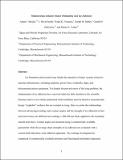Relationships between Water Wettability and Ice Adhesion
Author(s)
Meuler, Adam J.; Mabry, Joseph M.; Smith, Jonathan David; Varanasi, Kripa; McKinley, Gareth H; Cohen, Robert E; ... Show more Show less
DownloadMcKinley_Relationships Between AFM from July 2010.pdf (366.3Kb)
PUBLISHER_POLICY
Publisher Policy
Article is made available in accordance with the publisher's policy and may be subject to US copyright law. Please refer to the publisher's site for terms of use.
Terms of use
Metadata
Show full item recordAbstract
Ice formation and accretion may hinder the operation of many systems critical to national infrastructure, including airplanes, power lines, windmills, ships, and telecommunications equipment. Yet despite the pervasiveness of the icing problem, the fundamentals of ice adhesion have received relatively little attention in the scientific literature and it is not widely understood which attributes must be tuned to systematically design “icephobic” surfaces that are resistant to icing. Here we probe the relationships between advancing/receding water contact angles and the strength of ice adhesion to bare steel and twenty-one different test coatings (~200−300 nm thick) applied to the nominally smooth steel discs. Contact angles are measured using a commercially available goniometer, whereas the average strengths of ice adhesion are evaluated with a custom-built laboratory-scale adhesion apparatus. The coatings investigated comprise commercially available polymers and fluorinated polyhedral oligomeric silsesquioxane (fluorodecyl POSS), a low-surface-energy additive known to enhance liquid repellency. Ice adhesion strength correlates strongly with the practical work of adhesion required to remove a liquid water drop from each test surface (i.e., with the quantity [1 + cos θ[subscript rec]]), and the average strength of ice adhesion was reduced by as much as a factor of 4.2 when bare steel discs were coated with fluorodecyl POSS-containing materials. We argue that any further appreciable reduction in ice adhesion strength will require textured surfaces, as no known materials exhibit receding water contact angles on smooth/flat surfaces that are significantly above those reported here (i.e., the values of [1 + cos θ[subscript rec]] reported here have essentially reached a minimum for known materials).
Date issued
2010-10Department
Massachusetts Institute of Technology. Department of Chemical Engineering; Massachusetts Institute of Technology. Department of Mechanical Engineering; Massachusetts Institute of Technology. Laboratory for Manufacturing and ProductivityJournal
ACS Applied Materials & Interfaces
Publisher
American Chemical Society (ACS)
Citation
Meuler, Adam J., J. David Smith, Kripa K. Varanasi, Joseph M. Mabry, Gareth H. McKinley, and Robert E. Cohen. “Relationships between Water Wettability and Ice Adhesion.” ACS Applied Materials & Interfaces 2, no. 11 (November 24, 2010): 3100-3110.
Version: Author's final manuscript
ISSN
1944-8244
1944-8252